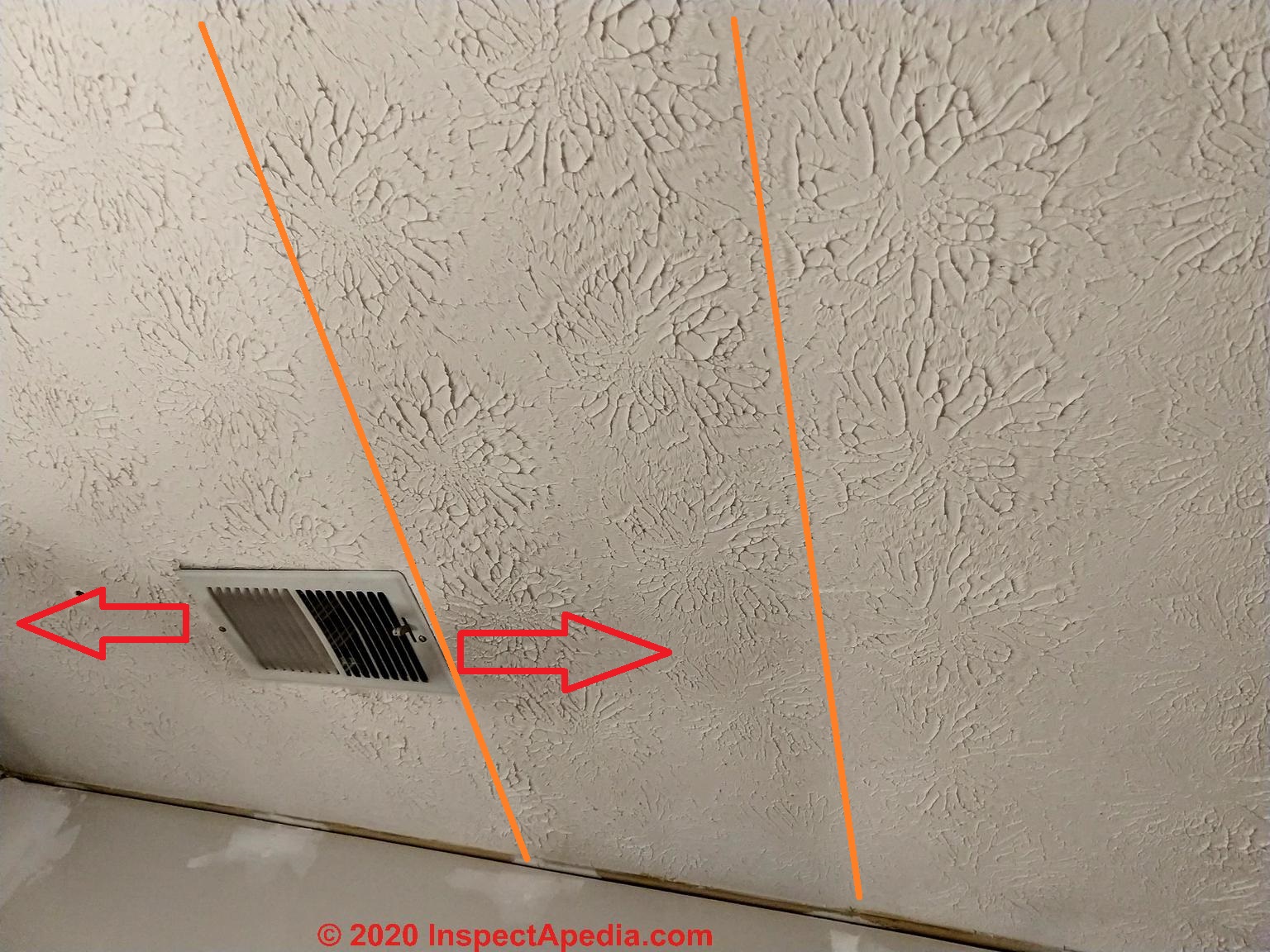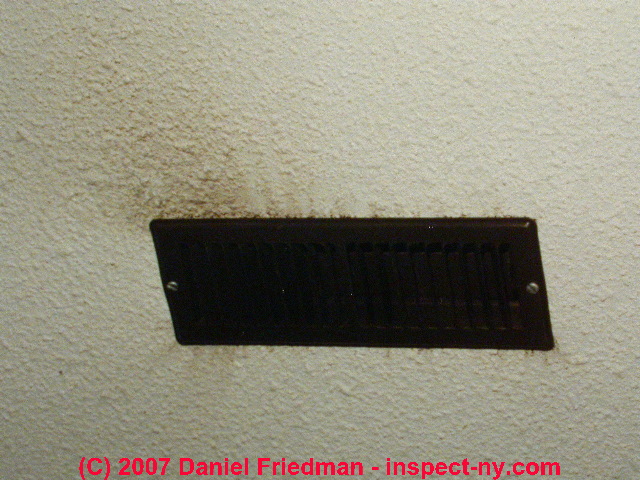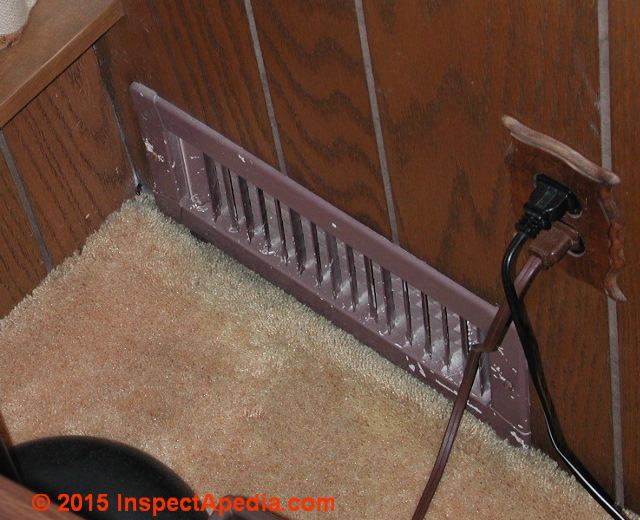 HVAC Dust or Soot Stains
HVAC Dust or Soot Stains
Diagnose Soot & Other Indoor Wall or Ceiling Stains
Traced to Heating or Air Conditioning Equipment
Stains at air supply registers
- POST a QUESTION or COMMENT about wall or ceiling stains that are traced to heating system problems
This article describes & diagnoses heating equipment as the cause of various interior wall and ceiling stains and explains how to recognize thermal tracking, thermal bridging stains, building air leaks, and building insulation defects.
Often these stains are mistaken for toxic indoor mold.
When investigating a building for a mold problem, you can save mold test costs by learning how to recognize Stuff that is Not Mold or is only Harmless Mold but may be mistaken for more serious contamination.
InspectAPedia tolerates no conflicts of interest. We have no relationship with advertisers, products, or services discussed at this website.
- Daniel Friedman, Publisher/Editor/Author - See WHO ARE WE?
Heating Systems & Other Sources of Dark Stains on Indoor Walls & Ceilings
Article Contents
- DISTINGUISH STAINS TRACED to DUCTWORK from OTHER BUILDING STAINS
- ABNORMAL STAINS AROUND HVAC AIR REGISTERS
- NORMAL HOUSE DUST STAINS at HVAC AIR REGISTERS
Watch out: our page top photo, sent by a reader, is a wonderful and unambiguous diagnostic photo that we discuss in more detail below - there is a serious soot problem with that heating system. Because there may also be safety concerns, prompt investigation is in order. .
...
Don't Confuse Problematic Duct or Register Stains with Other Indoor IAQ Problems
 The primary source of dark stains in this room is a problematic heating system in this photo courtesy of an InspectApedia reader discussed in this article's FAQs page linked at page bottom.
The primary source of dark stains in this room is a problematic heating system in this photo courtesy of an InspectApedia reader discussed in this article's FAQs page linked at page bottom.
Our red arrows mark black soot stains that show the path of air leaving the ceiling register - soot is blowing trough this HVAC duct system.
But notice also that between our orange lines (marking the probable location of ceiling joists) we see a larger soot-stained area. I think that that's probably an area of poor or leaky ceiling insulation, causing a cooler ceiling surface that that picked up and held more of the dust blowing out of the nearby air supply register.
Notice that the area between the orange lines that is sooty is darker where closer to the air supply register.
Watch out: black sooty stains in your building might point to very dangerous heating system carbon monoxide hazards, particularly if your heat fuel is LP or natural gas.
We explain this hazard at GAS BURNER SOOT CAUSE & CURE
Alternatively, such sooting from an oil fired heating system can tell us that there's an unsafe heat exchanger or an improperly-operating oil burner that risks a dangerous puffback explosion, as we explain
at OIL BURNER SOOT & PUFFBACKS
Be sure you have working CO Carbon Monoxide and Smoke Detectors in your building, then call your heating service company for help.
Don't confuse other indoor dark or sooty stains caused by air leaks or thermal tracking with stains that originate right at an HVAC system air supply registeer like those in our photo just above.
The stains in our page top photo and the photo just above are caused by the operation of the heating or air conditioning system without an air filter installed, by damaged, leaky, or contaminated ductwork, or by a serious dirt, dust, soot, or debris problem that is close to the return air inlet for these HVAC systems.
To compare these stains at air registers with other common indoor stains on walls and ceilings, see
...
Dirt, Debris, Stains around Heating or Air Conditioning Air Registers
The soiling and "stains" around the ceiling supply register for warm air or air conditioned cool air show that the air system is dirty, has inadequate filtration, or is operating unsafely.
Here's what we see that strongly suggests that the primary source of dark stains in this room is a problematic heating system:
- Black sooty stains are darkest right over the warm air supply register at the floor in the photo's lower right corner©
- There are no stains or soot marks on the building walls where pictures have just been removed
- Black sooty stains are less dark on the wall surface as we move higher on the wall away from the heating register
- Black sooty stains on other walls in the room are much less noticeable
While mold or other problem particles could be present in this dirt or debris, if they are present they are coming from another source, not from this soiled area on the ceiling.
Here the debris deposited on the ceiling is in a common pattern where warm or cool air supply registers blow air across the ceiling surface (including from leaks around the perimeter of the register grille in this case.)
The stain pattern is from building air movement, it is not thermal tracking and it is not, by itself, an indicator of problem mold.
A lab test of this debris for the presence of mold would not be justified based only on the observation of these stains, but it might be justified if there were other reasons to need to screen the building or its HVAC system for problem mold or other contaminants.
If you have frequent fireplace fires, cooking, or if you burn scented candles, if people smoke
in your home, or if your oil-fired or gas-fired heating system is not working properly, the added soot particle load in the building air is not only a health concern (soot and potentially lead), it also will mark the building surfaces in this characteristic pattern.
You can see examples of this staining
at STAINS CANDLES FIREPLACE WOODSTOVE
We welcome more thermal tracking, soot tracking, air bypass leaks, and similar photos of indoor stains as well as text suggestions to expand this detail and would be glad to credit contributors.
Usually soot marks, thermal bridging, or thermal tracking stains appear, if at all, in the building interior locations discussed in the remaining sections of this article.
...
Normal House Dust Deposits at a Heating or Air Conditioning Air Register
Above the light gray dust deposits at this heating air supply register look normal - that is, house dust, comprised principally of fabric fibers and skin cells is usually light gray in colour in such deposits.
Only by examination in a forensic lab will we know for sure what's in the dust on this register, but unless there is reason to suspect that there are contaminants in the system such testing is normally not appropriate.
See MOLD / ENVIRONMENTAL EXPERT, HIRE ?- when to hire an expert
Below is a close-up example showing typical light dust deposits on an air supply register.
The rust, depending on its cause and the source of moisture, might lead to a question of moisture, condensation, or perhaps mold contamination in the duct work of this building.
...
...
Continue reading at STAINS at HVAC REGISTERS or select a topic from the closely-related articles below, or see the complete ARTICLE INDEX.
Or see STAINS HVAC SOOT or DUST FAQs - questions & answers posted originally at this page and where you'll find more photos and examples of stains, dust, and debris around air ducts and their supply or return air registers.
Or see these
Recommended Articles
- AIR SEALING STRATEGIES - stop dust and debris stains by sealing air leaks
- AIRBORNE PARTICLE & MOLD LEVELS in DUCTWORK - where we describe how to test HVAC systems and ductwork for mold.
- BLOWER LEAKS, RUST & MOLD
- IAQ DIAGNOSIS via THERMAL TRACKING STAINS - clues that air is leaking in, around, or through building insulation
- MOLD / ENVIRONMENTAL EXPERT, HIRE ?- when to hire an expert
- MOLD on/in AIR DUCTS in HVAC SYSTEMS - photos of in-situ mold growth in or on actual ductwork
- MOLD on DUCT SUPPLY or RETURN REGISTERS - photos of in-situ mold growth on air supply and return openings and grilles.
- OIL BURNER SOOT & PUFFBACKS - signs of risk of or results of a dangerous explosion
- STAIN DIAGNOSIS on BUILDING INTERIORS - home
- STAINS CANDLES FIREPLACE WOODSTOVE
- STAINS DIAGNOSE IAQ PROBLEMS
- STAINS on INDOOR SURFACES, PHOTO GUIDE
- STAINS at HVAC REGISTERS
- STAINS on INDOOR SURFACES, PHOTO GUIDE
- THERMAL TRACKING BRIDGING GHOSTING - home
- WALL THERMAL TRACKING STAINS - examples of thermal tracking above a heating baseboard
Suggested citation for this web page
STAINS HVAC SOOT or DUST at InspectApedia.com - online encyclopedia of building & environmental inspection, testing, diagnosis, repair, & problem prevention advice.
Or see this
INDEX to RELATED ARTICLES: ARTICLE INDEX to BUILDING STAINS
Or use the SEARCH BOX found below to Ask a Question or Search InspectApedia
Ask a Question or Search InspectApedia
Questions & answers or comments about wall or ceiling stains that are traced to heating system problems.
Try the search box just below, or if you prefer, post a question or comment in the Comments box below and we will respond promptly.
Search the InspectApedia website
Note: appearance of your Comment below may be delayed: if your comment contains an image, photograph, web link, or text that looks to the software as if it might be a web link, your posting will appear after it has been approved by a moderator. Apologies for the delay.
Only one image can be added per comment but you can post as many comments, and therefore images, as you like.
You will not receive a notification when a response to your question has been posted.
Please bookmark this page to make it easy for you to check back for our response.
IF above you see "Comment Form is loading comments..." then COMMENT BOX - countable.ca / bawkbox.com IS NOT WORKING.
In any case you are welcome to send an email directly to us at InspectApedia.com at editor@inspectApedia.com
We'll reply to you directly. Please help us help you by noting, in your email, the URL of the InspectApedia page where you wanted to comment.
Citations & References
In addition to any citations in the article above, a full list is available on request.
- Thanks to Alan Carson, Carson Dunlop, Associates, Toronto, for technical critique and content suggestions regarding thermal tracking.
- Our recommended books about building & mechanical systems design, inspection, problem diagnosis, and repair, and about indoor environment and IAQ testing, diagnosis, and cleanup are at the InspectAPedia Bookstore. Also see our Book Reviews - InspectAPedia.
- In addition to citations & references found in this article, see the research citations given at the end of the related articles found at our suggested
CONTINUE READING or RECOMMENDED ARTICLES.
- Carson, Dunlop & Associates Ltd., 120 Carlton Street Suite 407, Toronto ON M5A 4K2. Tel: (416) 964-9415 1-800-268-7070 Email: info@carsondunlop.com. Alan Carson is a past president of ASHI, the American Society of Home Inspectors.
Thanks to Alan Carson and Bob Dunlop, for permission for InspectAPedia to use text excerpts from The HOME REFERENCE BOOK - the Encyclopedia of Homes and to use illustrations from The ILLUSTRATED HOME .
Carson Dunlop Associates provides extensive home inspection education and report writing material. In gratitude we provide links to tsome Carson Dunlop Associates products and services.




